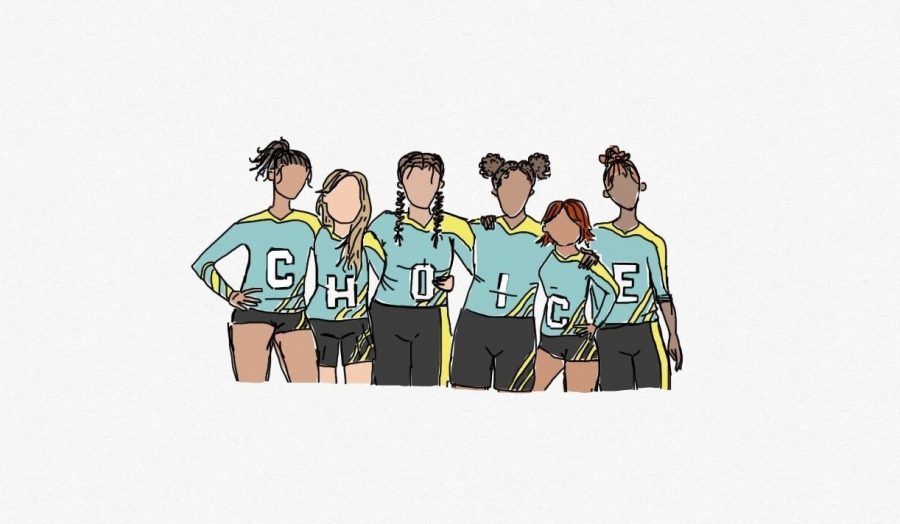From spandex to skirts: Sexism is rooted in female athletes’ uniforms
Female athletes everywhere are confined to the boundaries drawn by misogyny. Despite being as talented and diligent as their male counterparts, women in sports find themselves receiving fractions of the recognition and validation. In recent years, conversations have arisen surrounding the gender pay gap within professional sports. In basketball, golf, soccer, baseball, and tennis, male athletes make anywhere from 15% to almost 100% more than female athletes. To put this staggering wage gap into perspective, the highest base salary in the WNBA is $117,5000, whereas in the NBA it is $40 million. The drastic pay gap corresponds to the media’s sexist perspectives on athleticism. Women compose 40% of sports participants, yet female sports receive only 4% of sports media coverage. All these disparities confirm what all female athletes know to be true; women in sports are suppressed from fulfilling peak potential. Rather than be afforded glory and respect like their male counterparts, female athletes are drowned in belittlement, and disregarded. This blatant misogyny manifests itself across virtually every aspect of athletics, making far too much of competitive women’s sports about gratifying men. This is prominent in the contrasting uniforms of men and women. Women are almost always subjected to uniforms that are more revealing and less practical than what men wear. The uniforms worn by female athletes are designed to fit sexist standards and to appeal to the male gaze, rather than to ensure comfort while competing.
Female volleyball players are far too often the victims of gross objectification. Many have heard the infamous stereotypes on their appearances, or have listened to a male acquaintance “joke” about attending games to look at the players. Women’s volleyball is a main target of these degrading remarks because of the uniform requirements for players. Male volleyball players compete in a short sleeve jersey, paired with knee-length athletic shorts. To contrast, female volleyball players have a similar jersey style, but are required to wear two-to-four-inch long compression spandex instead of shorts. It is argued that the short spandex improves athletic performance by allowing more freedom of movement. However, if the choice of shorts really has such an extensive impact on gameplay, why is men’s volleyball not wearing a similar length or style? Additionally, other heavily mobile sports, such as soccer and basketball, wear uniforms similar to those of men’s volleyball.
It is important to remember nothing is inherently wrong with the spandex shorts themselves. In fact, if given the choice, many female players would likely choose to continue wearing them out of comfort and practicality. The nuance comes into play when this decision is withheld from women. It is at that point the spandex are no longer about enhancing athletic performance, but rather appealing to the male gaze.
Skirts have remained a prominent uniform piece in women’s sports for decades. In present day, they are most common in tennis, lacrosse, and golf. Unlike the justification of the use of spandex for volleyball, the requirement of skirts is often defended as “tradition.” However, tradition should not be immune to re-evaluation, especially when that “tradition” is rooted in sexist origins. The first tennis skirts were worn by female tennis players to conform to set gender expectations for appearance and modesty. Though the once ankle-length skirt has evolved over the years, the misogynistic values behind it certainly have not.
In 2018, tennis sensation Serena Williams made headlines while competing at the French Open. However, the media was not interested in her stellar performance, an achievement of its own considering the tournament occurred only nine months after Williams gave birth to her daughter. Instead, thousands expressed outrage towards her choice of uniform. In place of the typical white tank top and skirt, Williams wore a black bodysuit. The bodysuit was designed to prevent blood clots from forming, a severe health issue Williams faced following her pregnancy. Beyond its practicality, she wanted her uniform choice to inspire other women enduring post-pregnancy complications. Yet this reasoning was diminished by the French Tennis Federation president Bernard Giudicelli, who banned the uniform from being worn in any future French Open, claiming it was disrespectful to the game. The accusation that Serena Williams, a well-decorated tennis player with 23 Grand Slam titles, is disrespectful to the game is absurd. Giudicelli’s concern for William’s appearance over her health proves uniforms are still used to dismiss female athletes’ talent and achievements.
In recent years, beach volleyball has taken an important step towards diminishing sexism in women’s uniforms. When the sport was first introduced to the Olympics, men competing wore a tank top and shorts, while the women competing had to wear a bikini. In 2012, the International Volleyball Exertion eliminated the bikini mandate for women, and introduced new uniform options to accommodate all cultural beliefs. Extending flexible uniform choices to other sports of all levels would be much needed progress. Through allowing women to choose uniforms based on personal comfort, female athletes will begin to be loosened from the constraints of deeply rooted sexism.
Women in sports need to be granted more freedom in choosing uniforms. Whether that decision may be to compete in skirts, shorts, bodysuits, or bikinis makes no difference; the power is in the choice itself. When this option is withheld from women, the problematic origins of their uniforms continue to corrupt modern athletics. By addressing the sexism behind female athletes’ uniforms, a crucial step can be taken towards abolishing gender inequality in sports.
Hello there! Our goal is to provide relavent, engaging journalism for readers of all ages. Your donation will support the student journalists of the Wolfpacket at Claremont High School, and will allow us to purchase equipment, print our monthly issues, and enter in journalism competitions. We appreciate your consideration!

Melina Tisopulos is a senior and the Editor-in-Chief of The Wolfpacket. Melina loves to write and intends on studying journalism or English in college....







